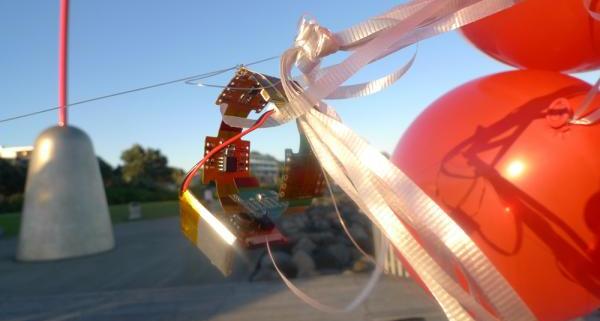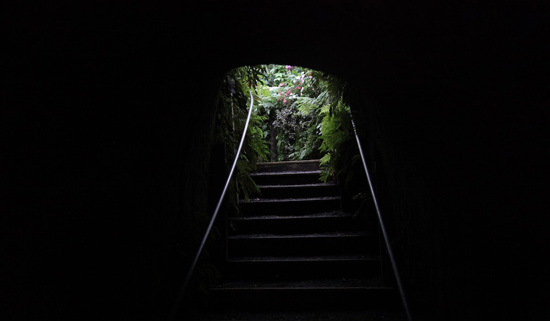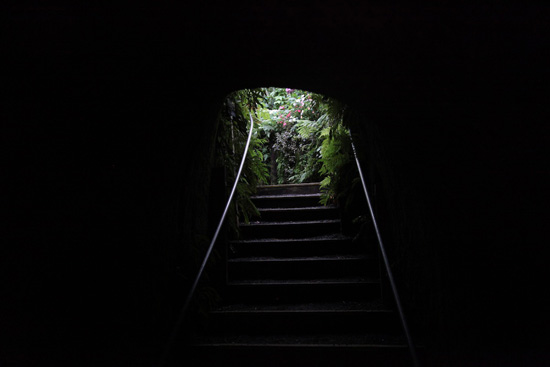Information Comes from the Sun – Julian Priest
Information Comes from the Sun 2011, Julian Priest, Solar powered monitor, Video animation, Media player, Photovoltaic cells
Open System Closed 2011, Julian Priest, Assemblage (nine underwater camera cases, found objects)
Discussion
“Information comes from The Sun” is a video artwork consisting of an animation of The Sun that was first shown at ISEA 2011 in Istanbul Turkey.
The animation is made from Solar Observatory data images of the sun that have been rendered in zero’s and ones using ascii art software and a custom font.
The animation shows a single solar rotation (28 days) photographed twice a day by the SOHO orbital instrument EIT304.
The animation may be connected to a one pixel camera that measures light levels and adjusts the resolution of the animation accordingly.
In the dark a single zero is shown – as light levels increase the number of characters increases until in the brightest light a full image of the sun is shown with every pixel a character.
Information comes from the sun represents the sun as an information source rather than an energy source – an information service provider.
What is it that we get from the Sun that we use up on Earth to power life?
Most people would say energy.
While The Earth is bathed in an enormous flow of energy from The Sun, it is not the energy that we use up on Earth. Energy from The Sun falls on Earth as visible light yet if we look at The Earth from space as an energy emitter, we see that it radiates energy as infrared light. In fact the incoming visible light energy and the infrared outgoing energy are more or less equal. If they were not in equilibrium The Earth would quickly explode. As a whole The Earth maintains an energy balance and therefore in cannot be the ENERGY from The Sun that we use up.
If we look at the incoming and outgoing energy streams we can however see that there is a frequency drop. This is related to a quantity called entropy which is a measure of disorder or energy disspipation. Entropy can also be thought of as the opposite of information. A system with higher entropy has less information. The information we are talking about here is not digital information 1’s and 0’s but possible physical states.
The entropy of the outgoing energy from the earth is greater – there is less information in the global output stream, than in the input.
This entropy gradient is what we use to structure life on earth – all the biology, culture and technology that we see on earth is a result of the process of converting the more ordered energy stream from the sun, into a more disordered output stream. We take a high information source, convert it into a low information source, and the difference stays with us on earth – as biosphere, civilisation, culture and technology.
If we think about it in this way it is clear that it really is information that comes from the sun – it is carried by a massive energy flow, but what the earth uses from the sun is the potential to order – to create structure or information.
In the field of non-linear thermodynamics it is shown that it is precisely the fact that life is efficient at degrading the entropic gradient that makes it possible to exist as a meta stable state at all.
When we reframe our understanding of the relationship between us and the sun as an informatic one rather than an energetic one there are some consequences. If we understand that the life process is not about energy, but about transforming energy in a
way that maximises information capture, we may choose to do things differently.
Currently we foreground access to energy resources politically with much emphasis placed on securing access to fossil fuels. This is a kind of quantative view of the world as resource. If however we focus on the informatic, we look not at how much energy we can capture, but how much structure we can produce for a given amount of low entropy energy or information.
Looked at this way a tree is worth more alive than dead, as an ecosystem rather than firewood. As a complex living structure of information it is vastly richer informationally than an information poor ash pile. With informational eyes we foreground efficiency over power.
With this artwork I’d like to begin to propose a different language for re-framing what are currently energetic issues as informatic ones. With this as a starting point we will have more luck in designing a sustainable infrastructure as we slowly but surely out of the fossil fuel era.
Julian Priest
05.11.2011











